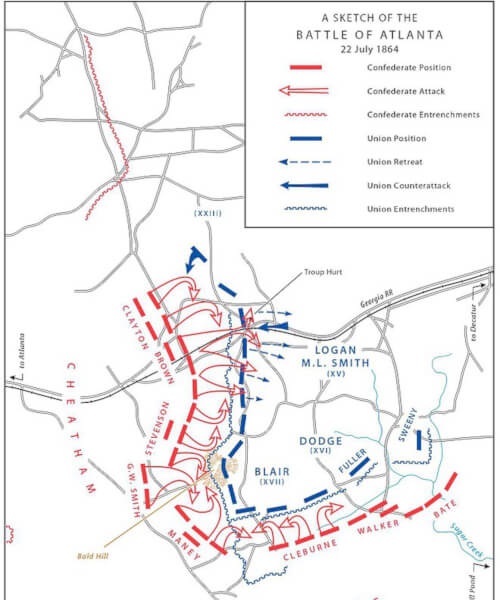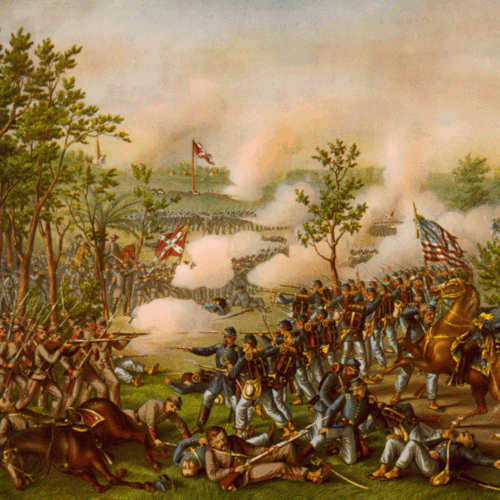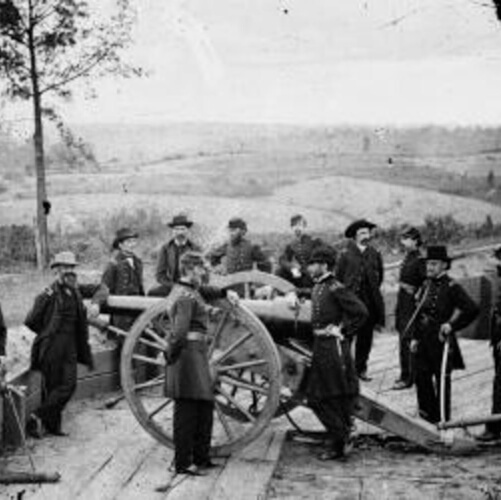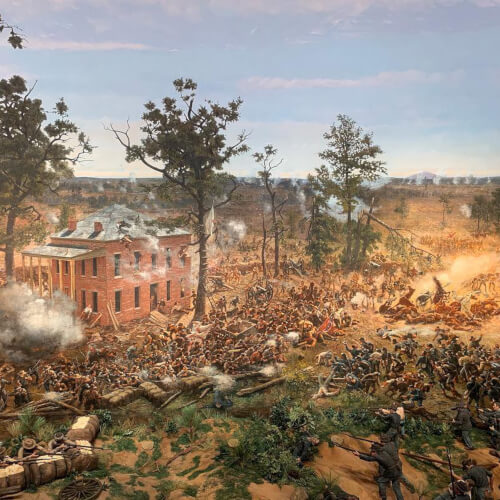Civil War Battles and Engagements
Exploring various battles and skirmishes of the Civil WarThe Battle of Atlanta
In the Civil War, artillery was an extremely important part in battles. The artillery was basically most firearms, cannons, and the ammunition and supplies that went with it. The most well known and famous of the artillery was the 12-pounder Napoleon.12 pounder Napoleon cannon. Field Cannons had to be hauled around attached to a limber(a wagon that carried the ammunition) and a team of horses. There were also smaller cannons and lots of rifles. There was field artillery(cannons and other guns used in land battles like Gettysburg), as well as siege and naval artillery(used in forts and on ships, which were mostly fixed canons and turrets of all shapes and sizes). The artillery played a vital role in the civil war in helping the infantry and cavalry, as one cannon could do as much damage as hundreds of rifles. Some examples of the tasks that artillery soldiers had to do was: Driving the teams of horses, steering and positioning the cannons for battle(which must have have a difficult task, considering the weight of the cannons used), loading the cannons, and operating the cannons and turrets.
Prelude to Battle
Under the direction of Lieutenant General Ulysses S. Grant, General Sherman launched his Atlanta Campaign in May 1864. At the start of his march, Sherman left Tennessee with 100,000 men. On his way south, Sherman met resistance from nearly 60,000 Confederate troops under General Joseph Johnston. As Sherman marched South, he would clash with Johnston on several occasions including in Resaca, Georgia and Kennesaw Mountain. Eventually, Johnston’s army was forced to retreat to Atlanta.
As a result of Johnston’s actions, Confederate President Jefferson Davis relieved Johnston of his command on July 17th and placed his troops under Lieutenant General Hood. Hood was the exact opposite of Johnston and wanted to attack rather than wait for the enemy. Hood began attacking Sherman’s troops on July 20th near Peachtree Creek and while he was defeated, he planned to continue this attack on the Union invaders
The Battle Begins
On the evening of July 21st, Hood’s 17,500 infantry and cavalry troops left the security of the defensive circles and began marching toward Sherman’s flank. After weakening the Union troops, the plan was for on the morning of the 22nd, Confederate troops would attack the Union army rear. The cavalry would wheel around to destroy Sherman’s supply train in hopes that it would be mostly unprotected.
As Sherman deployed troops to destroy the Atlanta railroad, he examined Atlanta’s defenses from the heights outside of the town. Sherman learned that Hood’s troops were no longer within the city’s defenses and ordered troops to find them. After consulting with his subordinates, Sherman recalled the troops and began reinforcing his left flank with troops and artillery.
The Battle Rages On
On the Confederate side, Hood’s plan of attack began to fall apart. After a delay in starting their attack combined with rough terrain and poor reconnaissance, Hood’s men were tired and out of position. Rather than being behind Union lines, Hood ended up on the reinforced left flank and six hours behind schedule.
The Confederates launched their attack around noon and the fighting centered on a hill east of the city known as Bald Hill which was the highest point between Atlanta and Decatur. As Union commander McPherson was inspecting his troops, he was shot from his horse and died shortly afterward. He was one of the highest-ranking Union generals to be killed in combat. Meanwhile, Union troops held their position against repeated Confederate attacks. For the next several hours, some of the most intense fighting took places as Hood’s troops attacked the Union lines on the hill. At one point, Confederate troops found a gap in the Union line and attacked and nearly succeeded in taking the hill, but in the end they had to fall back.
Union Victory
By late afternoon, the battle changed directions. Confederate troops found another gap in the Union lines near a railroad cut to the north of the city and attacked. This forced Union troops to temporarily fall back. It did not take long for Sherman’s troops rallied and counterattacked the Confederates. Using the high ground to their advantage Union artillery began to fire on Hood’s troops. After a long day of fighting, including hand-to-hand combat, the Union troops held the hill while Hood’s Confederates retreated to their defensive circles around Atlanta.
In the end, the North suffered approximately 3,500 causalities including Major General McPherson. The Confederates suffered around 5,500 casualties. The success of Sherman’s Atlanta Campaign including the fall of Atlanta was a major boost to Northern sentiment toward the war and helped Abraham Lincoln win reelection.
Key Players in the Battle of Atlanta
Major General William T. Sherman
William Tecumseh Sherman was born February 8, 1820, Lancaster, Ohio and began his Civil War career as a Colonel of the 13th U.S. Infantry Regiment and ended his career as the commanding general of the United States Army. He is best known for his actions in the Civil War, where his performance was mixed. Still, his “March to the Sea” in 1864 was a success in its goal to cripple the Confederate’s ability to wage war. His brutal and devastating method of waging war (“Hard War” he called it) remains controversial to this day.
General John B. Hood
John Bell Hood was born in June 1831 in Kentucky and after he graduated from West Point he served in the US Cavalry. At the outbreak of the Civil War, he joined the Confederate Army and was promoted to Colonel. At the Battle of Gettysburg he was severely wounded leading troops as they attacked Little Round Top and late lost a leg at the Battle of Chickamauga. After he recovered, he was promoted to Lieutenant General and took part in the Atlanta Campaign. Hood took command of the Army and began attacking Sherman’s troops but was forced to retreat to Atlanta which he held for several weeks. He also lost the Battle of Franklin and the Battle of Nashville and his army was destroyed.
Major General James B. McPherson
James Birdseye McPherson was born in November 1828 and graduated first in his class at West Point in 1849. He commissioned into the Army Corps of Engineers and after the start of the Civil War he served as Chief Engineer. He was promoted to Major General after proving himself at the Battle of Shiloh and the Battle of Corinth and was later promoted to Brigadier General. In the spring of 1864, he took over command of the Army of Tennessee and took part in Sherman’s Atlanta Campaign. During the fighting at the Battle of Atlanta, McPerson was shot and killed.
General Joseph E. Johnston
Joseph Eggleston Johnston was born February 3, 1807 in Farmville, Virginia and like many others commanders was a 1829 graduate of West Point. At the outbreak of the Civil War, Johnston resigned his Army Commission and was made Brigadier General in the Confederate Army and lead the Army of the Shenandoah. Johnston lead his men to victory at the first battle of the Civil War at Bull Run and would be promoted to General. He was wounded at the Battle of Fair Oaks and was replaced by Robert E. Lee. After recuperating, Johnston returned to lead Confederate troops and has the distinction of never losing a battle during the war. His military career was only hampered by his frequent disagreements with Confederate President Jefferson Davis.
Learn More
Videos
Vocabulary
Entrenchment: a trench or system of trenches dug by troops to provide a place of shelter from enemy fire.
Exploit: make full use of and derive benefit from such as a gap in the enemy line.
Flank: the right or left side of a body of people such as an army or a naval force.
Siege: a military operation in which enemy forces surround a town or building, cutting off essential supplies, with the aim of compelling the surrender of those inside.




